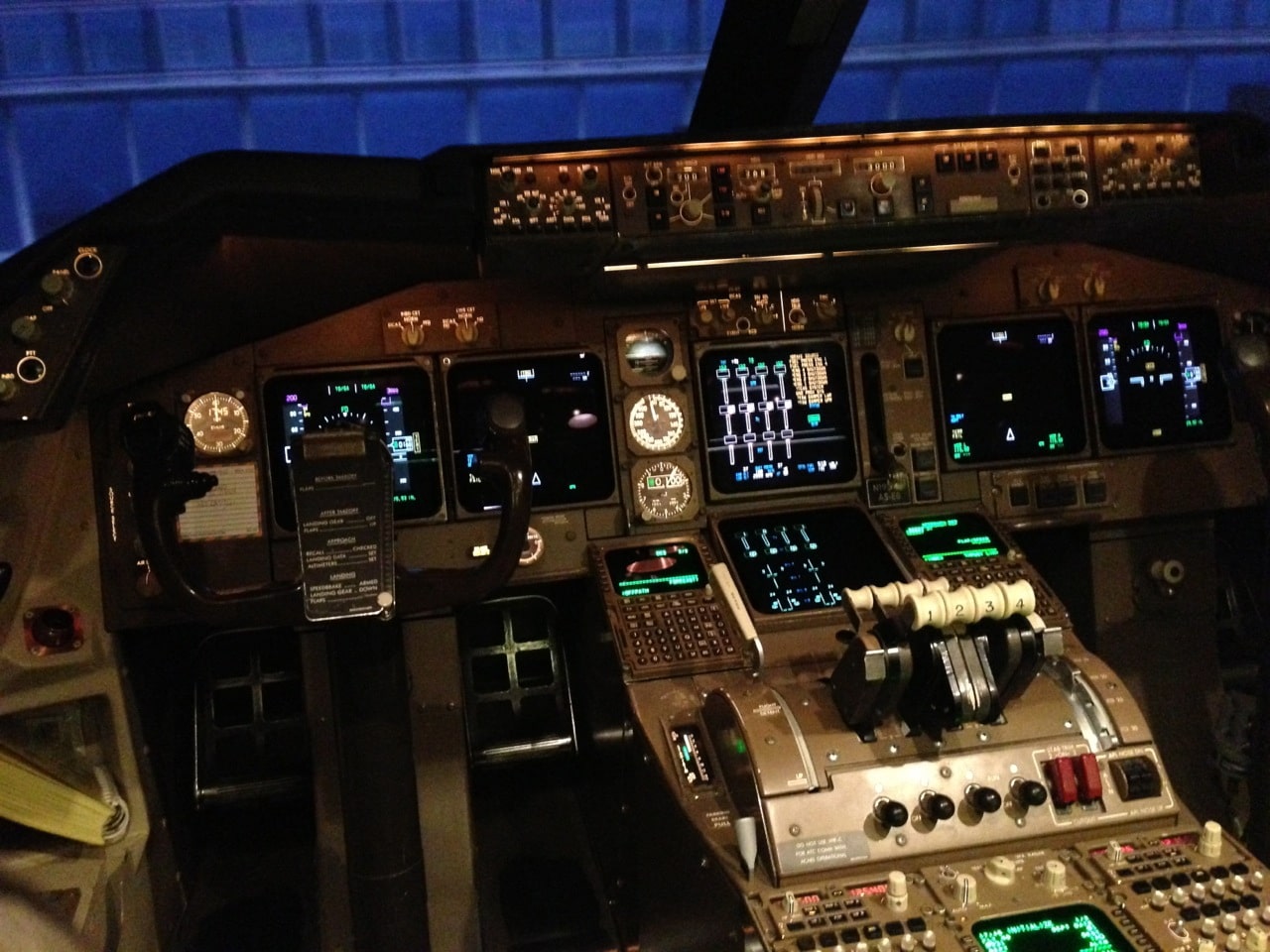After flying a number of aircraft over the years, my son Rick, and I had a unique opportunity to fly a Boeing 747-400 flight simulator at United Airlines in Denver, Colorado.
To keep my type ratings current, I fly a number of flight simulators which are integral part of flight training. Earlier in my career I developed software for Boeing 727 Head Up Displays, and flew simulators at Boeing, however I have never had the opportunity to fly such a large aircraft as the 747. Since these simulators are FAA-certified at the highest level, they must duplicate the aircraft with extreme accuracy. Bonus: Rick and I would be able to log 747-400 flight time!
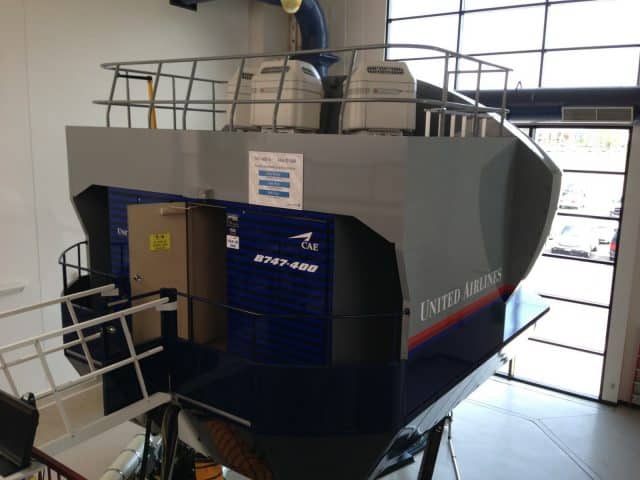
United 747-400 Simulator – Nice view through the windows, however you can’t see out of the simulator!
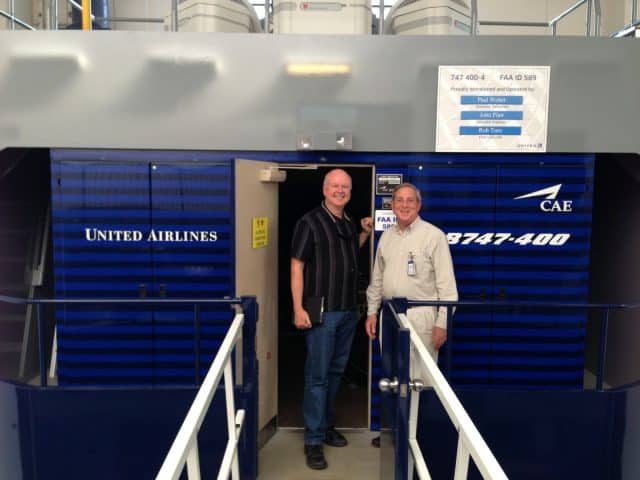
Rich and Captain Paul Singer boarding Boeing 747 simulator
The Boeing 747 entered service in 1969, and I first flew in one in 1971. My father worked for Continental at the time and I was fortunate to sit in the jump seat on a few flights, but never in the pilot seats. Today I was the Captain and Rick served as First Officer on this 747, which was modeled after United serial number 93.
A friend, Captain Paul Singer, who has amassed 25,000 hours in 40 years, gave us a cockpit brief on the 747 followed by a discussion of our flight plan. The original 747 had a Flight Engineer position, however with the upgrades in technology the 747 is now a 2 pilot aircraft, which results in a cockpit large enough to hold a gaggle of pilots!
Getting to know the cockpit
At first the number of controls and displays is confusing. However, the panel is extremely well designed once you’re introduced to the procedures. Once in the pilots’ seats all controls are within easy reach in the ample cockpit.
While some of this technology was developed over 20 years ago, it is still well designed and compares with today’s ergonomic standards; a testament to the Boeing engineers. Since this large aircraft is designed to be flown by 2 pilots, there is a great deal of automation, which can always be overridden by the pilots. After having flown a number of jets, it was nice to see some familiar displays!
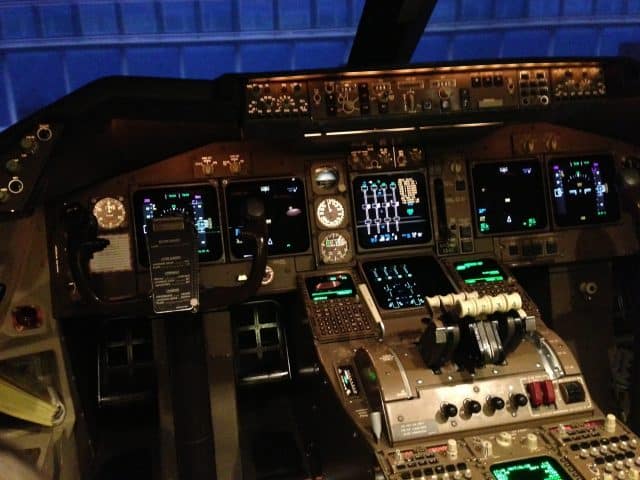
Cockpit of our 747-400 after our flight
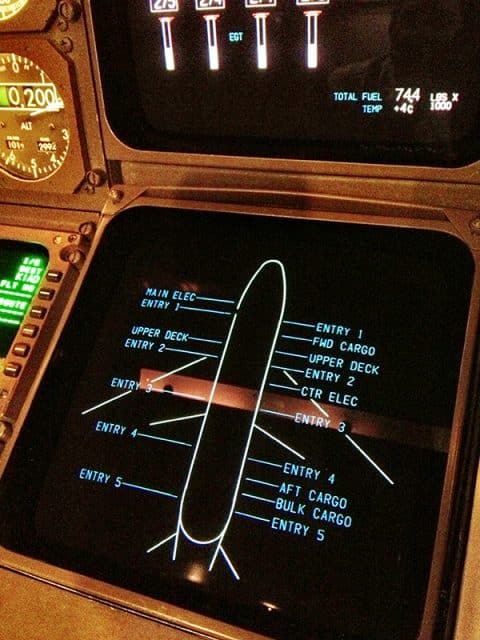
Reviewing the <acronym=”Engine Indicating and Crew Alerting System”>EICAS door synoptic page before leaving the jetways
Starting Engines
We decided to fly from Heathrow (EGLL) to Dulles (KIAD). Using an automated system to load a flight plan from United Dispatch, we loaded the flight plan into the FMC also sometimes referred to as a FMS. The FMC is remarkably similar to the one I’ve used in Cessna CJ2+ and CJ3 jets.
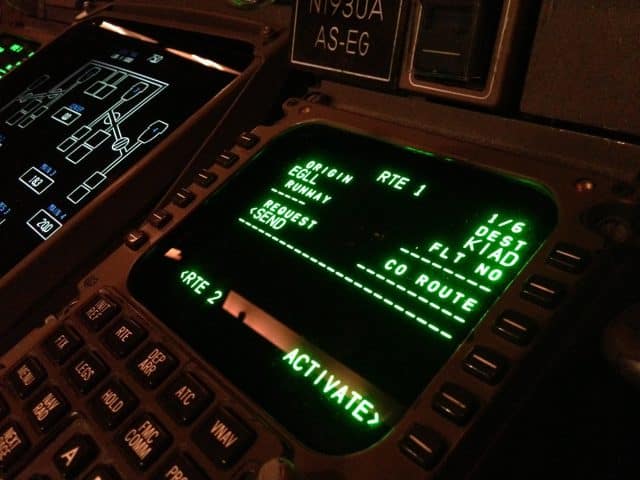
Flight Management Computer with our flight loaded
We only had 2 hours to fly, so only the initial waypoints were important, however we loaded and reviewed the entire flight across the Atlantic. For noise abatement we would fly a profile that avoided Windsor Castle, which sits on the departure path, as much as possible. We were going to use 27R, which is normally only used for landing to avoid bothering the Royals. The departure climb would have an initial segment to 1500 feet, a power reduction and slight turn followed by a continued climb.
We had a ZFW of 542,500 lbs and a maximum gross weight of 877,000 lbs. We were at maximum ZFW so we loaded 200,000 lbs of fuel. With eight tanks, including one in the horizontal stabilizer that holds 21,000 lbs., it is nice to have an automated method to balance the fuel. We would have to burn off at least 94,500 lbs. (14,000 gallons) of fuel to land at a maximum landing weight of 630,000 lbs.
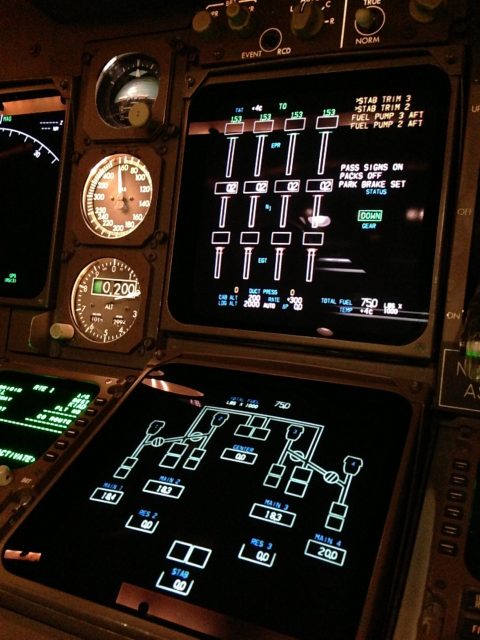
With eight fuel tanks, C.G. balance is critical – and automatic
We were parked at gate 247 at Heathrow. Under the guidance of Paul, after checking with the flight attendants that all passengers were seated with doors secured, I started the APU, which is a PT-6A in the tailcone. Once it was stabilized, I disconnected the GPU power and told the ramp crew to move the jetways, we had two!, and get ready for pushback. Once I verified the status of some systems, and flight control positions, Rick started the four PW40602 engines and confirmed they were operating within limits, and burning ‘only’ 1300 PPH each. With each engine capable of producing 63,300 lbs of thrust, it has immense power.
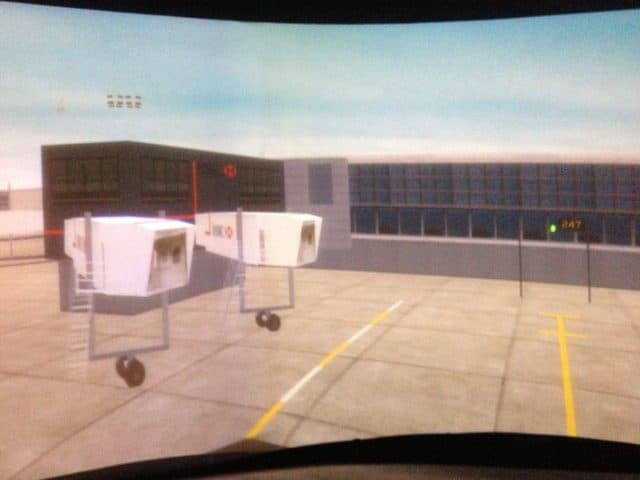
Our 747 being pushed back from the gate. It is great to have your own jetways!
After the tug pushed our 747 back from the gate. I set the parking brake and advised the ground crew to disconnect. Once confirmed, and with a taxi clearance, I released the parking brake and using the tiller taxied our 231 foot long aircraft, with a wingspan of 211 feet, down the smallest taxiway I’ve seen! Of course from 29 feet (8.9m) above the ground, any taxiway would look small. I remembered by father telling me of one of the first Continental 747s getting stuck in the mud in Denver in 1970. Even in the sim, it would have been embarrassing to have that happen on my first flight!
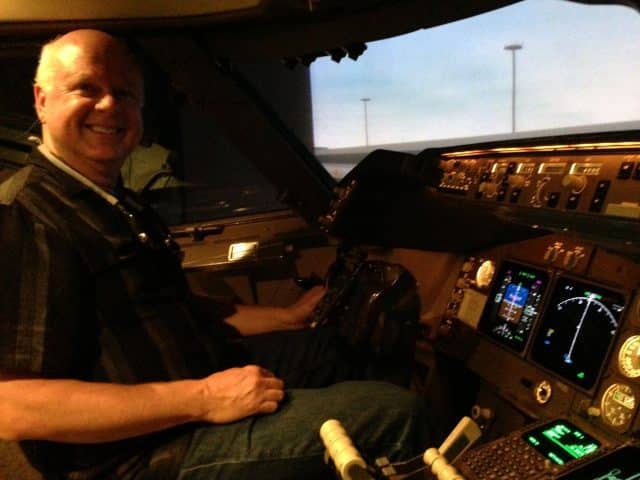
Taxiing the 700,000 lb 747 at Heathrow
Taking off from Heathrow, London
After receiving a takeoff clearance, I entered runway 27R, and lined up the aircraft for departure. Holding the brakes, I advanced the throttles to 60% power for spool up. When stabilized, I then advanced them fully forward and the auto throttles took over to maintain the proper settings. The 747 has great acceleration, reaching V1 (decision speed) of 136KIAS quickly. At VR -146 KIAS, I rotated all 742,000 pounds of aluminum, Jet-A, and people into the sky over London. Rick raised the gear and removed the flaps as we continued the departure profile and headed towards Scotland.
While the controls are heavier than most general aviation aircraft, with proper trim the airplane is amazingly nimble. I love steep turns, so of course one of the first activities was to practice several of them. Since we hadn’t turned off the Seat Belt sign for the passengers, we quickly entered steep banks before the meal service. Using Paul’s suggestions, we were holding 250KTIAS at 6,000 MSL with an engine EPR of 105-106. Rick and I were having a blast, trading turns flying this wonder of engineering in circles. With each engine burning over 14,000 PPH, we were quickly burning off our excess weight for landing.
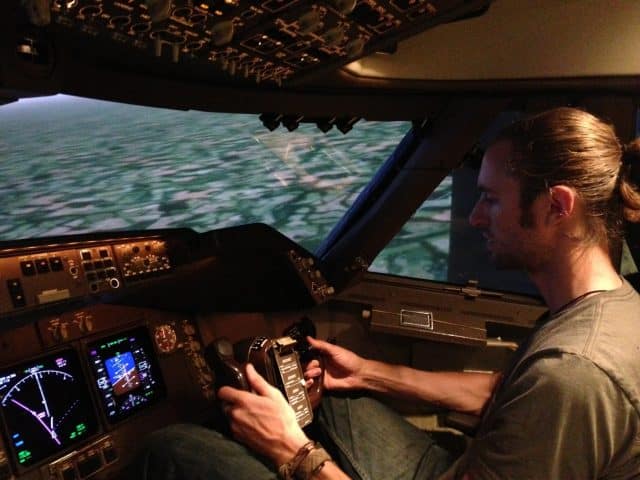
Rick flying steep turns over the English countryside at 250KIAS – in the 747
Heading back for approaches into Heathrow
We headed back to Heathrow to practice instrument landings, starting with an ILS to Runway 27R.
After loading the FMC, I was vectored to the final approach for the ILS by Paul. Using auto-throttle mode, I descended at 250KIAS in steps to 3,000 MSL slowing down to 200KIAS in the process. With Rick confirming the settings, he lowered the flaps in steps. Paul had warned us of the pitch change with flap extension, yet I was still caught a bit by surprise at the higher deflections.
Hand flying the ILS at 160KIAS with auto throttles disconnected, I forgot that 600,000lbs of aircraft was under my control. While a bit heavy on the controls, but nearly exactly the same feel as a Boeing 737 according to Paul, it was extremely stable. On the approach Paul briefed me on the power settings: 50 feet AGL retard throttles to idle, 30 feet AGL start to arrest the descent, 10 feet AGL pull back a bit more (but not too much to hit the tail).
We continued on the Runway 27R ILS towards Heathrow. Only slight changes were necessary to keep the needles centered once we intercepted the glideslope at 2500 MSL. The 747 encounters ground effect at 250 feet. At 50 feet, I retarded the throttles to idle and with so much momentum it didn’t seem to do anything. The aural RADAR altimeter then announced ’30 feet’ and I started to pull back on the controls. At the 10 feet AGL announcement, I leveled off and we were on the ground. The main gear wheel trucks are connected to speed brakes and automatically deploy a small amount when in fully contact with the runway. I engaged the thrust reversers and applied the brakes. As Paul had mentioned earlier, speed is very deceptive in this airplane. I thought we were slowing down sufficiently, until I noticed our IAS was still 120 Knots. With a stronger application of brakes, we came to a complete stop.
Rick then had a chance to fly the ILS. He was vectored to the 27L ILS. He flew the approach with almost perfect precision, a level that would be hard to beat with an autopilot. He flew down to the DH (Decision Height) that at the 50 feet callout retarded the power. At 10 feet he pulled back a bit too much and we did a slight bounce in the 747. I helped him get the plane back onto the runway and we stopped in plenty of time to taxi off 27L.
What a ride!
Paul teaches, and flies, these beautiful aircraft around the world. He has had opportunities to fly over unique parts of the world that only other pilots can dream about. Starting as a line boy at Clinton Aviation at Denver Stapleton, Paul worked nights so he could spend his money learning to fly. He even volunteered to ferry crew, generators, and even fly a radio station traffic plane to accumulate hours; all without pay.
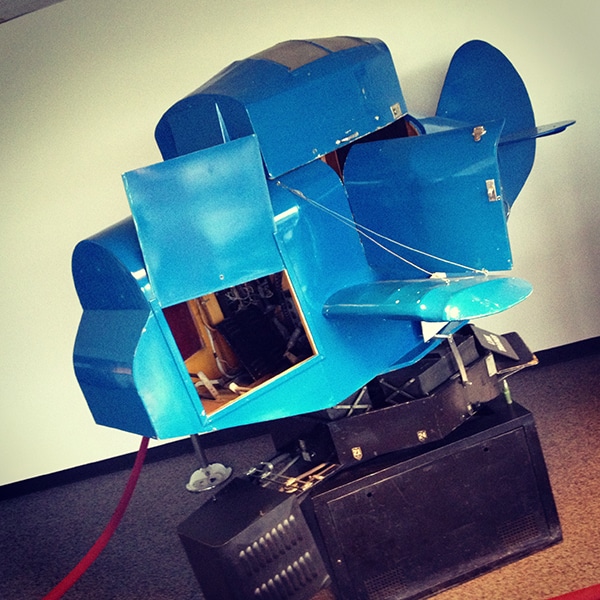
Original Link Trainer in United Airlines Flight Center in Denver
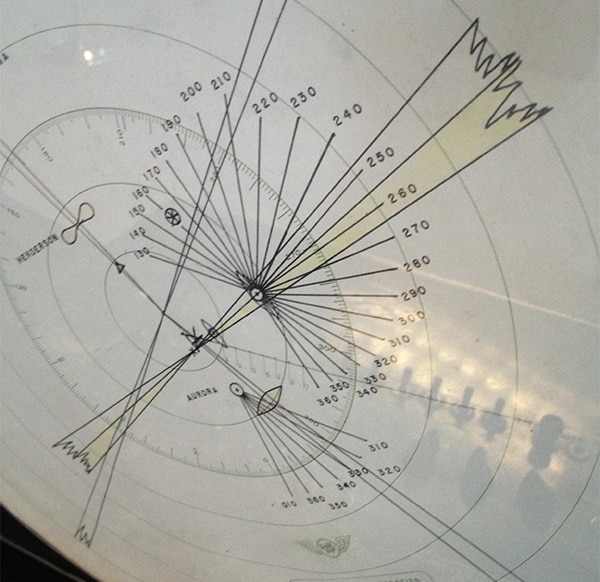
Close up of Link Trainer instructor’s station
At the United Training Facility they have the original Link Trainer that was at Clinton Aviation – the same Link in which Paul spent 20 hours towards his Instrument rating. You can tell that Paul still has the passion of flying and loves to share it with others. I’ll be teaching him in our Cirrus SR22, with a gross weight of 3400lbs! Knowing Paul, he will love it.
With 2 hours of 747 flight time under our belts, Rick and I just have to figure a way to complete the type rating!
